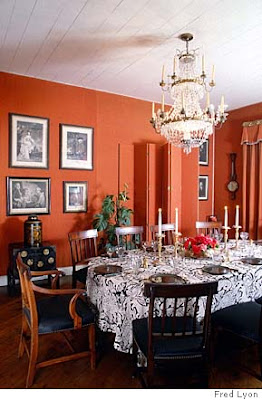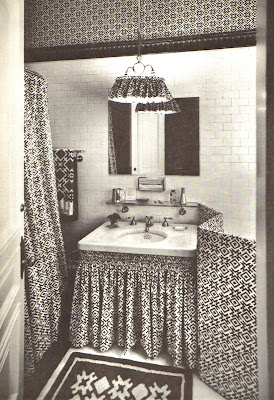
Screens are one of my favorite pieces of furniture for two simple reasons. First, they provide a dose of elegance and architectural interest to a room. Yes, there are some frightening screens out there, but for the most part, don't you usually see very chic screens? There are screens that are covered in charming fabric or wallpaper, and screens sheathed in glamorous mirror. And the ultimate, to me at least, is a Coromandel screen. Coco Chanel obviously agreed because her lacquered screen was the centerpiece in her iconic Paris apartment.
But aesthetic appeal aside, screens are also quite functional. Mirrored ones reflect light and shimmer in otherwise dark rooms. Some screens can hide that dead space in the corner of a room. Or, they can be used to mask the mundane, such as service doors between dining rooms and kitchens (this is why I call these type of screens "Service Screens", although I know that's not the proper term at all).
Decorative Screens
Designer Marcia Sherrill affixed this Coromandel screen to the wall above her living room daybed. (Photograph by James Weber NY)
Eliza Bolen cleverly used this gorgeous antique screen behind her caned bed- it certainly adds drama to the bedroom.
Mirrored Screens
Albert Hadley added this chevron-etched mirror screen to this Summery showhouse room.
I've always liked this simple mirrored fire screen designed by Kelly Wearstler, and it's certainly one of the easiest screens to make.
Functional Screens
This red dining room designed by Frances Elkins is a favorite of mine. Notice the screen used to hide a door (at least I believe it is hiding a door, but if not then let's just pretend it is). Elkins painted the screen in the same shade of red as the room's walls so that the screen would blend in with its surroundings. Since it's hiding something, why draw attention to it? (Photographer Fred Lyon)
This funny little half screen, in a bathroom designed by David Hicks, was used to hide the toilet. A little unusual I admit.
Half Screens
A half screen, hiding the piano legs, in the legendary living room of Syrie Maugham. You don't see too many of these little screens anymore, although I believe they were used quite frequently in interiors from the first part of the 20th c. Many examples I have seen were used to hide piano legs.
Image at top: A marvelous Vertes screen in the home of writer Amy Fine Collins
Great post. I love screens!
ReplyDeleteWhen I opened the post I thought, "Hmmm..I don't like screens." Turns out I do! These are the cream of the crop.Bolen and Sherill being the favorites.
ReplyDeleteThanks A! Me too!
ReplyDeletePatricia- I'd give my right arm for a Coromandel screen ;)
ReplyDeleteThese are all great examples but (no surprise) I'm partial to the "Eliza" bedroom. Jennifer, I'm with you on the Coromandel screens :)
ReplyDeleteI'll take a mirrored number--anyone know where to find one?
ReplyDeleteCourtney- That bedroom is just wonderful.
ReplyDeleteMillie- I've been told they're easy to make, however, if you don't want to do that, you can find them at antiques markets around here.
ReplyDeleteI'm with Jennifer--I would love an old coromandel screen. I also wouldn't mind having the ones that Horst P. Horst had in his Long Island house--covered in tapa cloth. My recollection is that he received either the fabric (or the actual screens) from Chanel.
ReplyDeleteNot to be crazy but for some reason, I think the Frances Elkins room is not painted but hung with fabric. Not that it matters and not that I am motivated to actually look it up.
ReplyDeleteAlso, Jeffrey Bilhuber did some fabulous little half screens in the apartment he did for the Starks featured in House and Garden a few years back. He used them to hide the heating/cooling elements below the windows. I remember them being creamy and possibly some sort of hide.
LOVE the Vertes screen!! - Too bad the wall treatment in Amy Fine-Collins apartment looks so dated
ReplyDeleteAs always another great post Jennifer. Like Courtney I love the Eliza Bolen room. It's one of my favorites for Bright Young Things.
ReplyDeleteJean-Michel Frank frequently used screens to hide pianos entirely in the 1920s and 1930s. But it wasn't just to hide a piano's legs. If you're going to decorate a room in shades of beige or white, a big, black piano is going to stick out like a sore thumb, so some camouflage is required. Similarly, Pauline de Rothschild used Frank-style low screens in her set at Albany in London, to hide the 19th-century cast-iron radiators from view.
ReplyDelete"Datedness" is a complicated business, isn't it? In this instance, if that wall treatment is dated, it's a form of datedeness I like very much. It's very atmospheric.
ReplyDelete-pt
I love that mirrored screen and the added light that it creates.
ReplyDeleteMorris- You know, I think I recall a photo of that?
ReplyDeleteAnon- Now that you mention it, you might be right. I didn't have access to my Frances Elkins book, so I had to go on memory. But I think you're right. The Bilhuber screens sound wonderful.
ReplyDeletedjellabah- I should have used that photo of de Rothschild's room! How could I forget that??!!
ReplyDeletelove.boxes- To me, a mirrored screen is classic!
ReplyDeletebklynxmas- That Vertes screen is fabulous!!!
ReplyDeleteVertès is a deeply underrated artist and well worthy of a revival. His advertisements for Schiaparelli are wonderfully evocative of the era. His illustrations for books by Daisy Fellowes and others are charming. And the lovely "French Garden" china he designed for Castleton China is true bliss.
ReplyDeleteWow, all great finds. I esp love the fire place screen!!
ReplyDelete~Kate
djellabah- I knew none of this about Vertès, so thank you.
ReplyDeleteKate- I wouldn't mind having one like that either.
ReplyDeletePeak I think it might be time to do a china story with that Vertès pattern!
ReplyDeleteWhere did I just see the Vertès screen?
Thanks for all the mini screen ideas I've got to hide an AC in a client's livingroom and I had been thinking of doing a shortie but hadn't thought of mirror or animal hide...
Mister- Glad I could help ;)
ReplyDeleteI think there was a Vertes screen in the Mario Buatta designed apt in the Feb AD???
a lovely detail worth noting re the red Elkins dining room ... the white ceiling is made of random-width planks ... what wonderful texture that adds!
ReplyDeleteThis must be Amy Fine Collins day. I just saw her photo in NYSD, and I had an email from a decor writer friend in S.F. who said "Elle Decor book given to her by her daughter featured the study of Ms. Collins, whose roloxed was near to exploding from the contacts of many years. Impressive"
ReplyDeleteAnd now your feature of the top photo. By the way, thanks for featuring one of my favorites of Albert Hadley's rooms and fabrics. That fabric will never grow tiresome, and I love the mirrored screen. Great post. I believe the Bilhuber screen is in New York Social Diary.
Hi Jennifer!
ReplyDeleteI am in the market for a screen to seperate my Living and Dining Rooms a tad more than they are right now, so this was a really fun post to see. Thanks! ;)
Great post, I don't think I've ever seen this many together before! Love the Syrie Maugham room!
ReplyDeleteTo me, screens are an artform. This gives one alot to look at in the way of screens. Chanel's screen is in my opinion, the peak of chic, and so was Coco Chanel.
ReplyDeleteAs beautiful as they can be, there's something psychologically disturbing about screens. It's as if the mind knows there's SOMETHING behind there, something unpleasant that's supposed to remain hidden from view. A pile of dirty laundry? Some ugly boxes? (With a fireplace screen, we know what's on the other side, so I don't find those disturbing.)
ReplyDeleteInteresting about the piano. The idea of hiding a Steinway seems ridiculous to a modern mind. You'd have to cordon off a big chunk of the room. Who in the world would you be fooling? And a grand piano is a beautiful, sculptural (and never mind expensive) object. Why hide it? Also, there are white pianos.
Originally, maybe 1/2 screens were used to hide the "legs" so that gentlemen of the time didn't think of curvaceous ladies legs??
ReplyDeleteEsp if it was popular at the turn of the century - not many ladies legs seen then.
And then as time went on people for got about the original reason and just used them for aesthetics
Anyway, I don't know - just a guess here anon.
:-)
What do you think Peak?
Freak me out! I just bought a painted leather screen from the 1920's yesterday!!!! I'm going to hang it as artwork. I could never afford a huge oil painting and the screen I bought is really just a huge oil painting!! I'll have to e- mail you photos!!
ReplyDeleteA white piano, alas, is about as classy as a white limousine. I'm going with the screen.
ReplyDeleteFor anyone looking for a room screen -- also check under the search name "room dividers" on sites like EBay or on the Net ....
ReplyDeleteJust a thought! Lovely posting -- I always thought those screens with the glass along the top were very sexy -- imagine a bespoke one with leopard print, curvy, black painted edges and a peek-a-boo top!
Jan at Rosemary Cottage who believes that some sights really should be screened ..... LOL!
Houses should always a screen! They are so elegant! I have 2...one made of shutters painted white in front of the bathroom window and one with creamy white organza curtains in the livingroom...Heavenly!I've bought a chinese laquered one wich will go in my bedroom...
ReplyDeleteThe post on Screens and the image of Eliza Reed Bolen's leather example had me rummaging through
ReplyDeletemy collection of tattered Vogue magazines from the 60s. In the Jan 15 1966 number they ran a story on Annette and Samuel Reed's NY apartment, and there was that VERY screen, ~the caption referred to it being 18th century Dutch.( Let's face it, Annette Reed De La Renta has the best taste in the world.)
Toby, I second that emotion about Annette de la Renta.
ReplyDeleteJennifer, or anyone-
ReplyDeleteThe great timeless fabric featured above in Hadley's Summer show house, (with the mirrored screens)
Is this fabric still made? I'd kill for a room in this fabric. I don't think I'd ever get tired of it, and I have been meaning to ask about it.
Fearful of the answer, but hopeful.
Jennifer! I am available for dancing in the street! You have found my fabric! Your post of 7/16/08 reveals the fabric I asked about above is Sister Parish's BURMESE!!!! Can't wait. That's my favorite favorite fabric!
ReplyDeleteThank you so much!